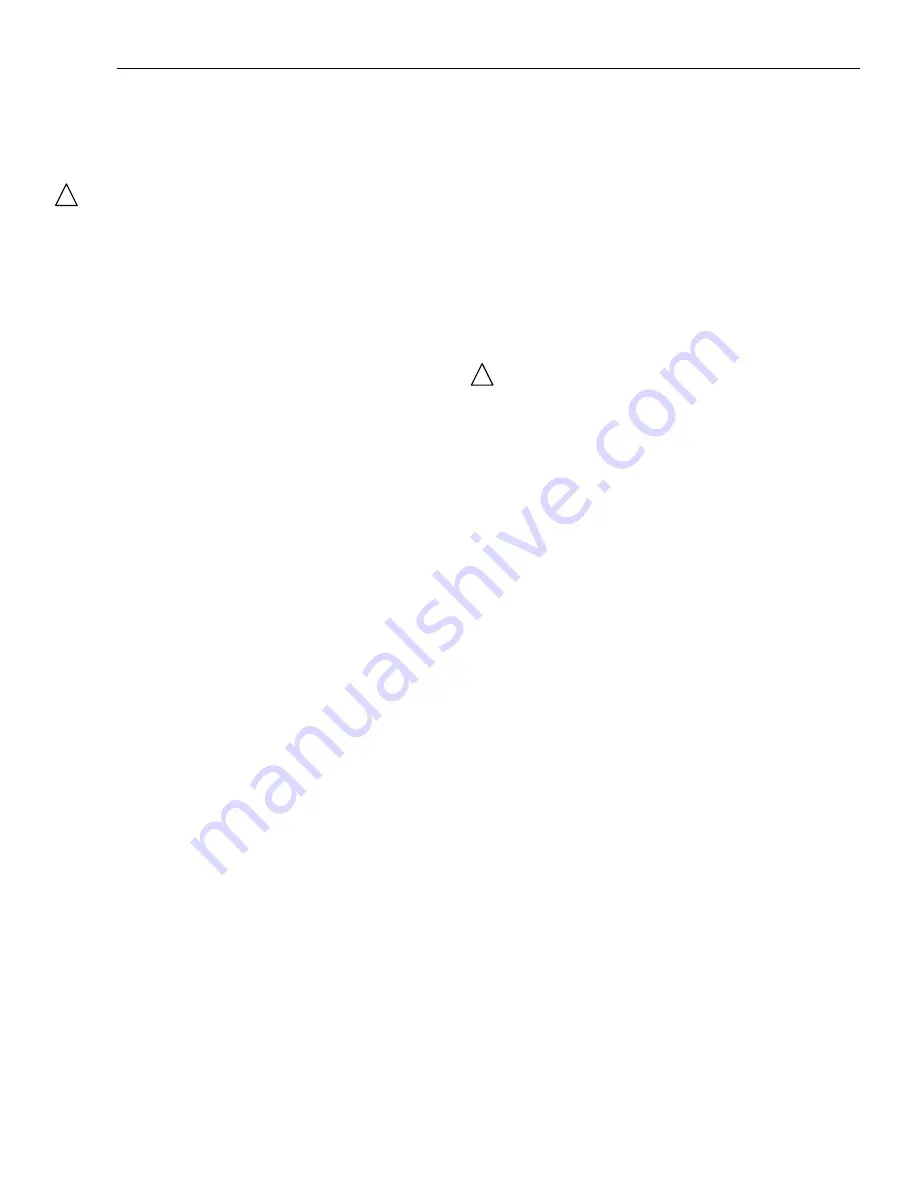
15
PIPING
Installation of Piping
Read these instructions completely before proceeding
with piping.
WARNING: This system contains dry nitrogen
under pressure and must be relieved before making
connections Nitrogen is nonpolluting and may be
vented to the atmosphere.
Remove access panels from compressor section. Prepare
to connect the two sections with clean dehydrated
refrigeration grade tubing. Recommended line sizes can
be found in Table 9. In order to assure oil return a velocity
of 1000 FPM must be maintained.
Use standard industry methods to install piping including
traps and risers as recommended for the total equivalent
feet.
Locations where copper tubing will be exposed to
mechanical damage should be avoided. If it is necessary
to use such locations, the tubing should be enclosed in
rigid or flexible conduit.
Horizontal piping runs should be supported enough to
prevent high binding stresses in the tubing. The weight of
vertical piping may be either supported with riser clamps
bearing on structural members of the building or by a
platform at the bottom of the riser.
Supports should be strong enough to handle any load by
thermal expansion or contraction of the pipe so that
stresses will not be placed on the equipment to which the
piping is connected.
The suction line, hot gas bypass, and both hot gas reheat
lines (if included) should be insulated with 5/8" minimum
thickness closed cell foamed insulation, to prevent
sweating or heat loss.
All lines
, except the liquid line, must
be insulated. However, on installations where the liquid
line is exposed to high ambient areas, the liquid line must
be insulated to prevent subcooling loss. Refrigerant lines
run underground should be insulated with 3/4" minimum
thickness closed cell foamed insulation.
Suction horizontal lines must be pitched toward the
compressor unit, see Figure 13 on page 15.
When the air handler is installed at a higher elevation than
the compressor, provide a vertical loop in the suction line
adjacent to the air handler to a point at least to the top of
the evaporator coil. Do not insulate the refrigerant or
condensate drain lines until all joints in these lines are leak
tested.
WARNING: This system contains dry nitrogen
under pressure and must be relieved before making
connections. Nitrogen is nonpolluting and may be
vented to the atmosphere.
Purge holding charge from the condensing unit by opening
both the high and low pressure gauge ports on the
condensing unit and allow holding charge to bleed off to
atmospheric pressure.
Drill a 1/16" bleed hole in the cap on the suction line fitting
of the air handler (Larger of the two fittings) and allow
holding charge to reduce to atmospheric pressure.
Remove caps on the suction and liquid lines of the outside
section by drilling a small hole in the caps and then apply
heat to caps to remove. The caps are soldered to the
fittings with soft solder.
Carefully clean the suction line and liquid line fittings on
the outside and braze the refrigerant lines to these fittings.
Leave gauge port open until all brazing is completed. Low
pressure nitrogen purging is recommended while brazing.
INSTRUCTIONS FOR PIPING HOT GAS BYPASS
Before piping this refrigerant circuit it is important to read
the Installation of Piping Instructions. See page16.
Locate the hot gas bypass tee (factory installed) at the
evaporator coil. It is located between the thermostatic
expansion valve and the distributor.
Locate the hot gas bypass circuit connection in the
condensing unit. The hot gas bypass valve and solenoid
are factory installed.
See Table 9, Notes 5 & 6.
Size the piping between the evaporator and condenser for
a minimum pressure drop. See Table 9 for recommended
line sizes.
The piping should be free draining to the evaporator tee
connection to ensure oil return to the compressor.
Connect the piping with clean, dehydrated refrigerant
grade tubing. Use standard industry practices to install the
refrigerant line.
!
!
Содержание RCA051
Страница 8: ...8 DIMENSIONS...
Страница 9: ...9 DIMENSIONS Continued...
Страница 10: ...10 DIMENSIONS...
Страница 11: ...11 DIMENSIONS Continued...
Страница 14: ...14 TYPICAL FIELD WIRING DIAGRAM...
Страница 17: ...17 FIELD WIRING DIAGRAM...
Страница 24: ......
Страница 26: ...26 NOTES...
Страница 27: ...27 NOTES...
Страница 28: ...28...














































